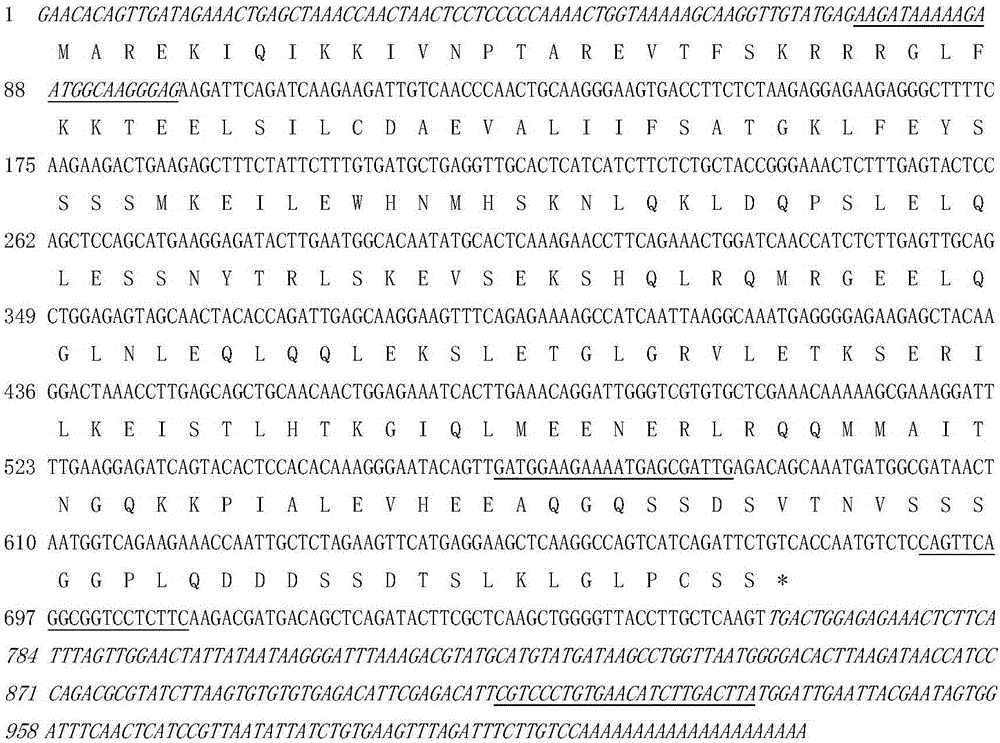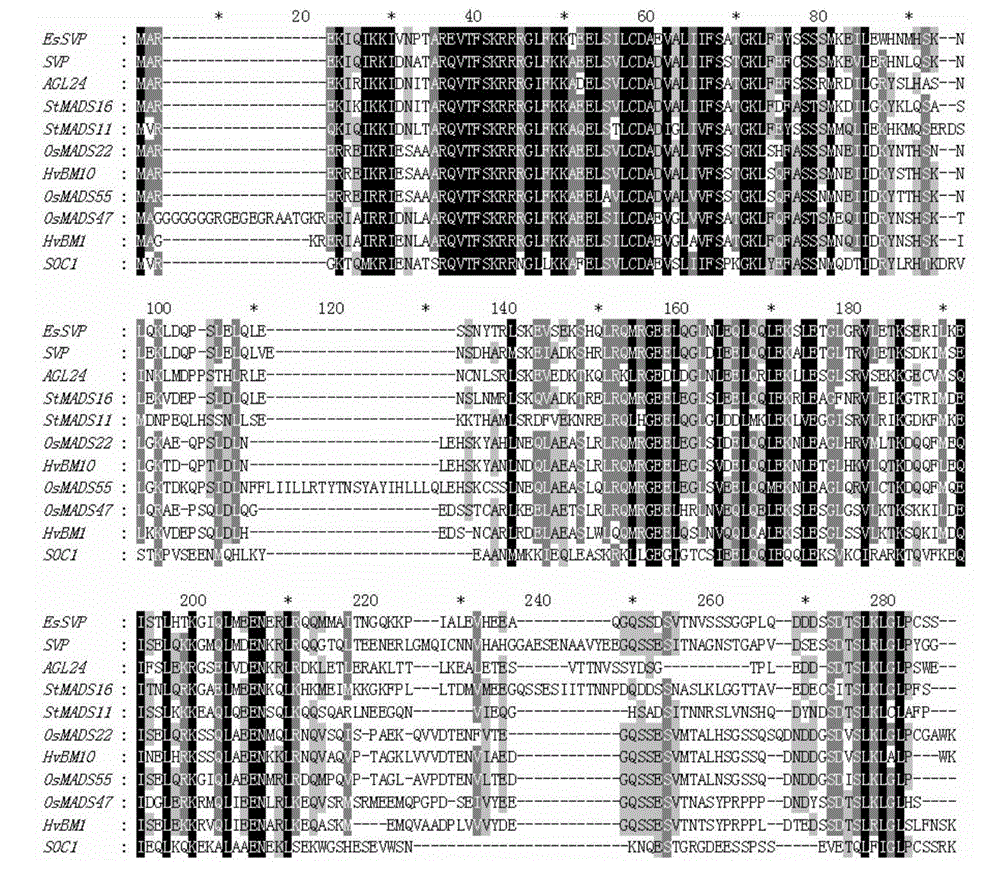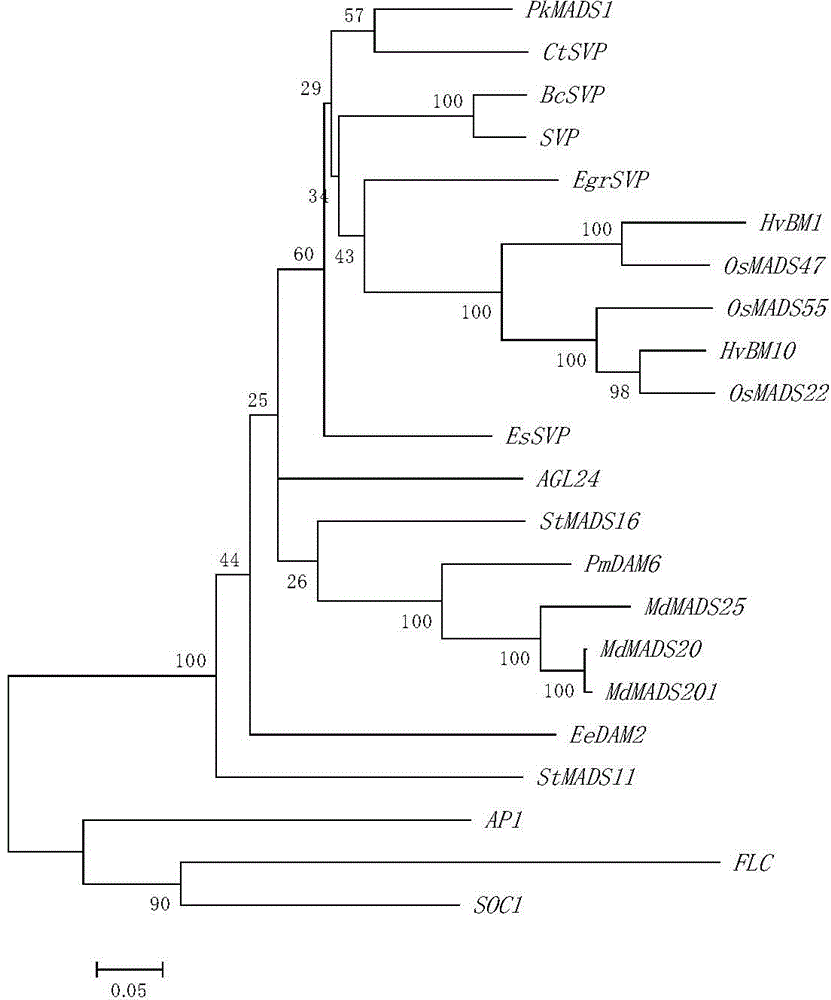Herba epimedii EsSVP protein, gene coding same and application thereof
A kind of epimedium and gene technology, applied in the field of genetic engineering, can solve the problem that the petals and sepals of Epimedium are not found.
- Summary
- Abstract
- Description
- Claims
- Application Information
AI Technical Summary
Problems solved by technology
Method used
Image
Examples
Embodiment 1
[0025] Cloning of Example 1 Epimedium EsSVP Gene
[0026] 1 gene clone
[0027] 1.1 Extraction of total RNA
[0028] (1) Take Epimedium leaves, grind them fully with liquid nitrogen in a mortar baked at 180-200°C, and quickly pour them into a DEPC-treated centrifuge tube. After the liquid nitrogen evaporates, press 1ml reagent / Add an appropriate amount of Trizol (plant RNA extraction reagent) to 100 mg of the material, vortex and mix, and place at room temperature for 30 minutes.
[0029] (2) Centrifuge at 12000rpm for 10min, and suck the supernatant to another centrifuge tube.
[0030] (3) Add 0.2 times the volume of Trizol in chloroform to the supernatant, mix well, and place at room temperature for 5 minutes.
[0031] (4) Centrifuge at 12000rpm for 10min, keep the water phase, and suck it into another centrifuge tube.
[0032] (5) Add an equal volume of isopropanol to the water phase, mix thoroughly, and place at -20°C for 2 hours.
[0033] (6) Centrifuge at 12000rpm,...
Embodiment 2
[0107] Example 2 Agrobacterium-mediated Epimedium EsSVP Gene Transformation (Arabidopsis thaliana)
[0108] 1 Construction of expression vector
[0109] According to the experimental requirements, in this example, the characteristics of multiple cloning restriction sites on the vectors pMV and pBI121 were utilized to digest the cDNA fragments on the cloning vectors and directly connect them to the expression vectors.
[0110] 2 Preparation of Agrobacterium GV3101 and EHA105 Electrically Competent Cells and Transformation of Expression Vectors
[0111] (1) Pick fresh single colonies of Agrobacterium GV3101 and EHA105 in 10mL LB liquid medium, and cultivate them with shaking at 28°C until the late logarithmic period;
[0112] (2) Take 1mL of bacterial liquid and add it to 100mL of fresh LB liquid medium, shake and cultivate to OD at 28°C 600 About 0.5-1.0;
[0113] (3) Transfer the bacterial solution to a 50mL centrifuge tube and place on ice for 30 minutes;
[0114] (4) Cen...
Embodiment 3
[0134] Example 3 Agrobacterium-mediated transformation of Epimedium EsSVP gene (Petunia)
[0135] 1 Agrobacterium-mediated petunia transformation (leaf disk transformation method)
[0136] The explants were cultivated in a greenhouse, and the vigorously growing leaves of wild-type petunia W115 were taken. For specific transformation methods, see Horsch et al.1985.
[0137] 2 tissue paraffin sections
[0138] The pistils at different developmental stages were fixed with FAA fixative, and the paraffin sections were prepared according to Horsch, R.B. et al. (1985). The sections were 8-mm thick and stained with eosin-toluidine blue (Igersheim and Cichocki, 1996).
[0139] Overexpression of 35S::EsSVP transformed petunias did not affect cymose branches and had little or no effect on flowering time, but obviously changed flower development. Calyx enlarged, sometimes leaf-sized ( Figure 7 A, C, D, H). The corolla tube turns green, and the petals cannot fully open (partially lose...
PUM
 Login to View More
Login to View More Abstract
Description
Claims
Application Information
 Login to View More
Login to View More - R&D
- Intellectual Property
- Life Sciences
- Materials
- Tech Scout
- Unparalleled Data Quality
- Higher Quality Content
- 60% Fewer Hallucinations
Browse by: Latest US Patents, China's latest patents, Technical Efficacy Thesaurus, Application Domain, Technology Topic, Popular Technical Reports.
© 2025 PatSnap. All rights reserved.Legal|Privacy policy|Modern Slavery Act Transparency Statement|Sitemap|About US| Contact US: help@patsnap.com



